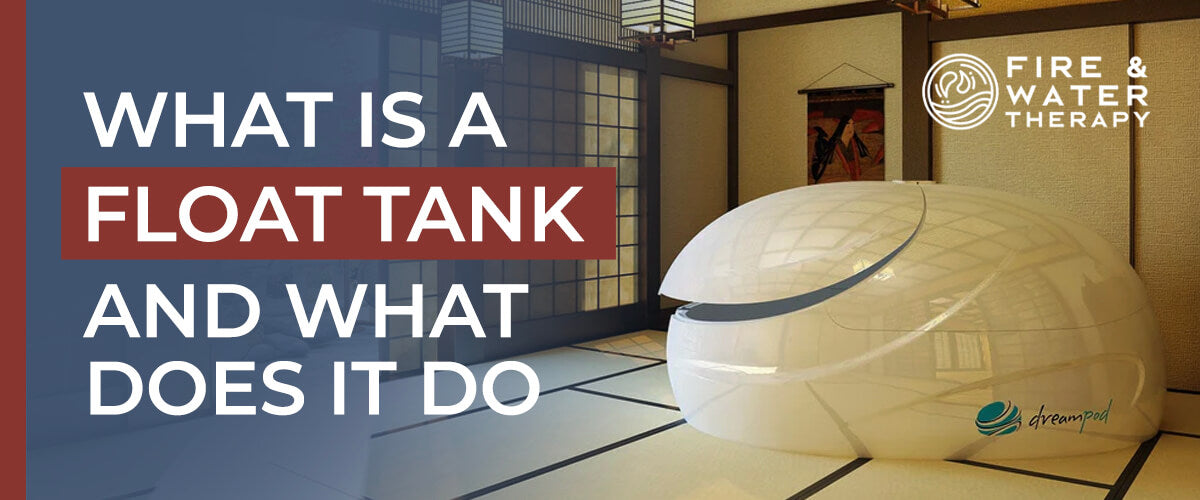What Is a Float Tank and What Does It Do?

The world’s buzz and noise can negatively affect a person’s health. Everything can be overwhelming and can result in anxiety and stress. If you feel overwhelmed with all your work and responsibilities, one way to cope is through sensory deprivation using a float tank. It’s a form of therapy.
In this article, learn more about this therapy, specifically what float tanks are and what they do. Find out all the benefits you can enjoy when using one. Most importantly, get valuable tips on how you can use one to improve your overall health.
What Is a Float Tank and How Does It Work?
It’s also known as floatation or sensory deprivation tank. Simply put, it’s an enclosed, horizontal tank that is partially filled with salty water when used. It’s a dark, soundproof pod where an individual submerges themselves in the water. They’re meant to not see and hear anything, hence the term sensory deprivation.
Basically, it’s the apparatus used for floatation therapy. In this therapy, Epsom salt is combined with water and heat. Here’s a quick overview of how it works and how it’s used:
- The tank usually contains water filled to a depth of around 300 millimeters..
- Epsom salt is then added to the water, usually around 800 pounds.
- The solution is heated up to the outer skin temperature, usually 95 degrees Fahrenheit.
The saltwater solution will make you float in the water without exerting too much effort. Plus, since the tank is enclosed, it reduces your exposure to external stimulations, like sound, touch, and light. Since you’ll be floating on your back, with your head partially submerged, you’ll be able to create a feeling of relaxation. This will encourage you to enter a meditative state.
Benefits of Float Tanks and Flotation Therapy

Float therapy using the tank can have numerous positive benefits on the mind and body. These include:
Deep Relaxation
The environment in the tank completely isolates you and your senses from all distractions. As you get settled in the soothing embrace of the water in the tank, you gain moments to release any tension in your body. This is mainly because of the Epsom salt and water solution.
This allows you to enter a relaxed state while floating inside, and as you relax, you’ll be able to reduce your anxiety and stress. In fact, a 2018 study found that a tank session can significantly reduce anxiety and improve the moods of the participants with stress- and anxiety-related disorders.
Better Sleep
As you enter a state of deep relaxation in the tank, you get more engaged with sensory deprivation. This promotes a profound sense of calm. This will allow you to enter a state similar to deep sleep, where you can rejuvenate and recharge. Even after your session, that calmness can help you enjoy better sleep at night.
Aside from that, you can even sleep in the tank. It’s not dangerous to do so, as you won’t roll over and drown because of the buoyancy of the Epsom salt solution. It would be difficult to turn over while you’re floating, so you’ll surely stay on your back even if you fall asleep.
Relieve Migraine
Epsom salts are high in magnesium, which is important to ease migraines. Studies have shown that people with migraines tend to have lower magnesium levels than people who don’t get headaches. By exposing yourself to increased amounts of magnesium from the Epsom salts, you can relieve and even prevent migraines.
Detoxification
The magnesium in the salt can also flush out toxins and heavy metals from your body. This will help ease any pain in your body, like muscle pain, and clear out any harmful substances you might have picked up from the outdoors and environment.
Physical Relief
Flotation therapy, in general, also works in relieving physical pain. It slows down your heart rate and even reduces your high blood pressure. Plus, the Epsom salt in the water can draw out lactic acid in your body. This can then contribute to the relief of the soreness of your muscles and the healing of your overworked muscles.
Boost Imagination
When you’re inside the tank, there’s nothing else you can do but immerse yourself in the darkness and quietness of the enclosed space. This will allow you to magnify the power of your imagination and visualization. You can simply close your eyes and let your mind wander. Conjure up scenarios that will invoke a sense of joy and serenity. For example, you can imagine yourself in a quiet and lovely meadow surrounded by flowers. This can even boost your creativity.
Improve Cardiovascular Health
Floatation therapy is a form of restricted environmental stimulation therapy (REST). Remember, sleep deprivation and chronic stress are often linked to cardiovascular disease and high blood pressure. According to research, floatation can induce deep relaxation. This will help reduce your stress levels and improve your sleep, which are essential for improving cardiovascular health.
Who Can’t Use Floatation Tanks?
In general, float tanks are safe to use for most healthy people. However, to ensure an individual’s safety, you need to know who shouldn’t be using one. First off, these tanks aren’t suitable for people under 16. Most importantly, they’re not recommended for people with certain medical conditions, including:
- Low blood pressure
- Claustrophobia
- Epilepsy
- Open wounds
- Skin ulcers
- Kidney disease
- Diarrhea
- Any contagious disease
7 Important Tips for Using Float Tanks

To ensure that you get the most out of your floatation tank, here are some valuable tips to consider and follow:
1. Eat Before a Session
Make sure you eat at least 30 minutes before your floatation sessions. This will help you relax and avoid getting distracting stomach growls and hunger pains during the session. However, make sure to avoid taking caffeine hours beforehand and don’t take drugs and alcohol as well. Taking them might result in unpleasant experiences and hallucinations while inside the enclosed space.
2. Perform the Necessary Preparations
A float session usually takes an hour and requires preparation. Aside from eating, here are the more advanced preparations you need to do:
- Remove all your jewelry and any piece of clothing.
- Make sure to shower before entering the tank.
- You can wear a swimsuit if you don’t want to go completely undressed inside the tank.
- Wear and use earplugs before entering the tank. This is only if water in your ears would make you uncomfortable.
3. Make Sure You Do It Properly
For good sessions and results, you have to ensure that you’re using the tank and doing the therapy properly. Here are some necessary tips:
- Find a comfortable position and focus on breathing slowly and deeply.
- Give yourself time to get used to the water's stillness and the tank's environment.
- Breathe from your diaphragm.
- If you ever get nervous inside, do your best to focus on your breathing again.
- Avoid touching your face while floating on the water. The salt can irritate your eyes and can get in your nose.
4. Try Meditation
Float tanks can provide an ideal environment for meditation: quiet and still. You can use this solitude and tranquility to practice meditation and explore different techniques. Ultimately, all you have to do is focus on your breathing, visualize positive imagery and scenes, and repeat affirmations.
If it’s your first time or if you’re a beginner in meditation, here are some steps you can take when inside the tank:
- Let your body and mind embrace the stillness of the tank.
- When inhaling and exhaling, pay attention to the sensations from each breath.
- If your thoughts begin to wander, gently redirect your attention and focus back to your breathing.
5. Perform Soft Stretches
Since you’ll be floating weightlessly inside the tank, your spine will be able to decompress naturally as the buoyancy can support your whole body. This will allow you to elongate and release muscle and joint tension. That’s why, after about 20 minutes of your session, do some good, soft stretching.
You can follow these tips to do some soft stretches:
- Slowly extend your limbs and reach out in different directions to let your muscles gently stretch.
- Extend your arms as far as you feel comfortable and feel the gentle pulls and sensations as you do.
- Pay close attention to your spine and feel the gentle release of pressure on your back.
- Add some gentle twists while stretching, like slowly rotating your torso left and right. These can improve your flexibility and relieve tightness.
While doing these stretches, make sure to listen to your body. Always stretch your body within your comfortable range of motion only. Avoid doing any movements that can strain your body or cause discomfort. Remember, the goal is to relax and release, not push your body.
6. Be Aware of the Potential Risks
Even though float tanks have lots of good points, they could also have some downsides. Before you try them, besides checking for the medical issues we talked about earlier, make sure you know about possible bad effects of using the tanks and the therapy overall.
Based on different research, using the tanks can have minimal negative side effects, including:
- Dry mouth and mild itching
- Panic
- Dissociation
- Psychosis and flashbacks
- Skin rashes
- Skin irritation
- Swelling
7. Clean and Maintain the Tank
Generally, bacteria don’t grow in highly salty waters, like the Epsom salt solution in the tank. But this doesn’t mean that it’s not possible. You need to maintain proper tank care and hygiene to avoid any possibility. Follow these measures to do so:
- Make sure to shower before entering the tank to get rid of any dirt or bacteria from your body.
- Filter the salt water solution between your float sessions.
- Make sure to physically clean the tank’s interior surfaces regularly.
- Disinfect the tank either using ultraviolet (UV) light and bromine or chlorine.
Ultimately, make sure to check the manufacturer’s instructions for tank maintenance. This is because some cleaning products may be suitable for some tank designs and models but damaging to others.
Conclusion
Float tanks are necessary for good floatation therapy sessions. They offer a wide range of physical and mental health. They can even boost your creativity and problem-solving skills. However, ensure you understand what to do and not to do when using one.
If you’re still searching for a good tank, you can visit our float tank collection. We offer high-quality products to ensure enjoyable and fruitful sessions!




